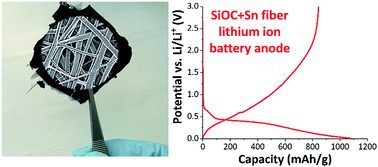当前位置:
X-MOL 学术
›
Sustain. Energy Fuels
›
论文详情
Our official English website, www.x-mol.net, welcomes your feedback! (Note: you will need to create a separate account there.)
Continuous silicon oxycarbide fiber mats with tin nanoparticles as a high capacity anode for lithium-ion batteries†
Sustainable Energy & Fuels ( IF 5.6 ) Pub Date : 2017-10-23 00:00:00 , DOI: 10.1039/c7se00431a Aura Tolosa 1, 2, 3, 4, 5 , Mathias Widmaier 2, 3, 4, 5, 6 , Benjamin Krüner 1, 2, 3, 4, 5 , John M. Griffin 7, 8, 9, 10 , Volker Presser 1, 2, 3, 4, 5
Sustainable Energy & Fuels ( IF 5.6 ) Pub Date : 2017-10-23 00:00:00 , DOI: 10.1039/c7se00431a Aura Tolosa 1, 2, 3, 4, 5 , Mathias Widmaier 2, 3, 4, 5, 6 , Benjamin Krüner 1, 2, 3, 4, 5 , John M. Griffin 7, 8, 9, 10 , Volker Presser 1, 2, 3, 4, 5
Affiliation

|
Continuous fiber mats are attractive electrodes for lithium-ion batteries, because they allow operation at high charge/discharge rates in addition to being free of polymer binders and conductive additives. In this work, we synthesize and characterize continuous Sn/SiOC fibers (diameter ca. 0.95 μm), as a Li-ion battery anode. Our synthesis employs electrospinning of a low-cost silicone resin, using tin acetate in a dual role both as a polymer crosslinker and as a tin precursor (6–22 mass%). The hybrid electrodes present very high initial reversible capacities (840–994 mA h g−1) at 35 mA g−1, and retain 280–310 mA h g−1 at 350 mA g−1. After 100 cycles at 70 mA g−1, the hybrid fibers maintained 400–509 mA h g−1. Adding low amounts of Sn is beneficial not just for the crosslinking of the polymer precursor, but also to decrease the presence of electrochemically inactive silicon carbide domains within the SiOC fibers. Also, the metallic tin clusters contribute to a higher Li+ insertion in the first cycles. However, high amounts of Sn decrease the electrochemical performance stability. In SiOC fibers synthesized at high temperatures (1200 °C), the Cfree phase has a significant influence on the stability of the system, by compensating for the volume expansion from the alloying systems (Sn and SiO2), and improving the conductivity of the hybrid system. Therefore, a high amount of carbon and a high graphitization degree are crucial for a high conductivity and a stable electrochemical performance.
中文翻译:

含锡纳米颗粒的连续碳氧化硅纤维毡可作为锂离子电池的高容量阳极†
连续纤维毡是锂离子电池有吸引力的电极,因为除了不含聚合物粘合剂和导电添加剂外,它们还可以在高充电/放电速率下工作。在这项工作中,我们合成并表征了连续的Sn / SiOC纤维(直径约0.95μm),作为锂离子电池的阳极。我们的合成方法是对低成本的有机硅树脂进行静电纺丝,同时使用乙酸锡作为聚合物交联剂和锡前体(6-22质量%),两者起双重作用。的混合电极呈现非常高的初始可逆容量(840-994毫安汞柱-1在35毫安克)-1,并保留280-310毫安汞柱-1在350毫安克-1。在70 mA g -1下循环100次后,杂化纤维维持400–509 mA hg -1。添加少量的Sn不仅有益于聚合物前体的交联,而且有利于减少SiOC纤维内电化学惰性的碳化硅畴的存在。而且,金属锡簇在第一循环中有助于更高的Li +插入。然而,大量的Sn降低了电化学性能的稳定性。在高温(1200°C)下合成的SiOC纤维中,自由碳相通过补偿合金化系统(Sn和SiO 2的体积膨胀)对系统的稳定性产生重大影响。),并提高了混合系统的电导率。因此,高碳含量和高石墨化度对于高电导率和稳定的电化学性能至关重要。
更新日期:2017-10-23
中文翻译:

含锡纳米颗粒的连续碳氧化硅纤维毡可作为锂离子电池的高容量阳极†
连续纤维毡是锂离子电池有吸引力的电极,因为除了不含聚合物粘合剂和导电添加剂外,它们还可以在高充电/放电速率下工作。在这项工作中,我们合成并表征了连续的Sn / SiOC纤维(直径约0.95μm),作为锂离子电池的阳极。我们的合成方法是对低成本的有机硅树脂进行静电纺丝,同时使用乙酸锡作为聚合物交联剂和锡前体(6-22质量%),两者起双重作用。的混合电极呈现非常高的初始可逆容量(840-994毫安汞柱-1在35毫安克)-1,并保留280-310毫安汞柱-1在350毫安克-1。在70 mA g -1下循环100次后,杂化纤维维持400–509 mA hg -1。添加少量的Sn不仅有益于聚合物前体的交联,而且有利于减少SiOC纤维内电化学惰性的碳化硅畴的存在。而且,金属锡簇在第一循环中有助于更高的Li +插入。然而,大量的Sn降低了电化学性能的稳定性。在高温(1200°C)下合成的SiOC纤维中,自由碳相通过补偿合金化系统(Sn和SiO 2的体积膨胀)对系统的稳定性产生重大影响。),并提高了混合系统的电导率。因此,高碳含量和高石墨化度对于高电导率和稳定的电化学性能至关重要。


























 京公网安备 11010802027423号
京公网安备 11010802027423号